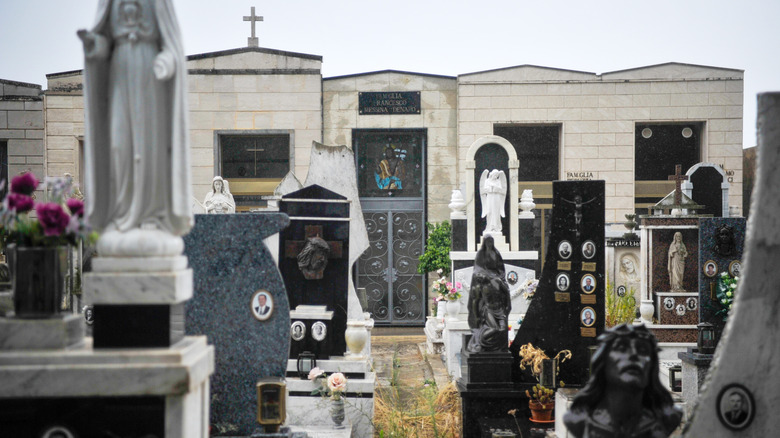Do Mausoleums Smell Like Decay?
Here's an idea: Take one or several dead bodies, place them in a contained room on little shelves in the wall, or even behind the wall, seal the whole thing up, and try not to gag from the stench if you ever head back inside. That makes at least cursory sense, right? Of course a building filled with the decomposing corpses of the once-living would be filled to the gills with steaming bodily gases hissing out of putrefying remains, you might say. Well, the next time you head into a mausoleum — maybe just for kicks on a random Wednesday afternoon — tip your nose into the air and take a big ole' whiff. The most you and your goth friends might be able to say is, "Hmm, smells a bit stale. Disappointing."
So no, mausoleums in fact do not smell like rotten flesh and pools of fetid organ juice. After all, mausoleums are nothing new — humanity has had a long time to figure out, "Hey, maybe there's a better way to seal up decaying meat, blood, and bones." Enter: engineering. As the good people at A Good Goodbye say, mausoleums are built from the ground up with sanitation in mind. A "successful entombment," as the site says, consists of five key principles: materials that last, excellent seals to enclose certain portions of the mausoleum, adequate valves and ventilation, liquid-absorbent lining within various chambers, and an overall construction that keeps maintenance and access in mind.
Ancient preservation of the dead
Before going on, we should clarify a couple of terms. A mausoleum is an above-ground monument that houses the dead that it honors, as Matthew Funeral Home and Cremation Services says. On one hand, it memorializes them. On the other hand, it's basically a jumbo-sized, walk-in headstone. Mausoleums can be as modest as the small, cubical ones like those at the well-known St. Louis Cemetery No. 1 in New Orleans. Or, mausoleums can be as gobsmackingly grandiose as the Taj Mahal in Uttar Pradesh, India — it all depends on money, status, morals, beliefs regarding the afterlife, and so forth. But if there's no corpse inside, it's not a mausoleum. And if the body is below ground level, it's not a mausoleum — that would be a crypt. However, mausoleums above ground can connect to crypts below ground.
While it makes sense for humans to bury their dead, interring the dead above-ground seemingly came much later. The first record we have of an ornate, giant mausoleum is the Mausoleum at Halicarnassus in modern-day Turkey. As Mausoleums.com says, it was built in the mid-4th century B.C.E. to house and honor the Persian ruler after whom every such monument was named: Mausolus. Regardless of ancient ventilation and sealing techniques, old mausoleums wouldn't smell bad because the person inside died so long ago. Modern mausoleums need some technological assistance to stay stench-free.
Containing human gases and fluids
Ultimately, if a mausoleum is properly constructed it won't smell bad inside — at least to a degree. Casket Questions states that there are three specific techniques used to prevent a mausoleum from getting rank. We mentioned ventilation to let gases escape, but a mausoleum also needs good drainage to funnel liquid away. The interior of the mausoleum can also be lined with tiled floors to filter away fluids that do happen to leak. If done right, the mausoleum itself acts like a second casket, which when combined with good temperature control, moisture control, and mortuary methods like embalming can prolong the decay of a body up to 80 years.
However, judging by first-hand mausoleum-visiting stories like that on Beyond the Pall, even the most hygienic mausoleums can't perfectly seal away smells. The deeper you go, the air gets bad and "sweet," as multiple comments read. And judging by those comments, some folks don't think it's worth the effort or sanitary risk to store a decomposing body above ground. This is especially true if multiple bodies are placed inside the mausoleum, or the bodies aren't placed inside a casket — both of which would require more and more assiduous containment methods. The Gardens of Boca Raton Cemetery and Funeral Home says that some mausoleums can contain crypts for an entire family. Others don't contain bodies, but urns in little niches in the wall. Given the choice, those mausoleums might be the better ones to visit.


